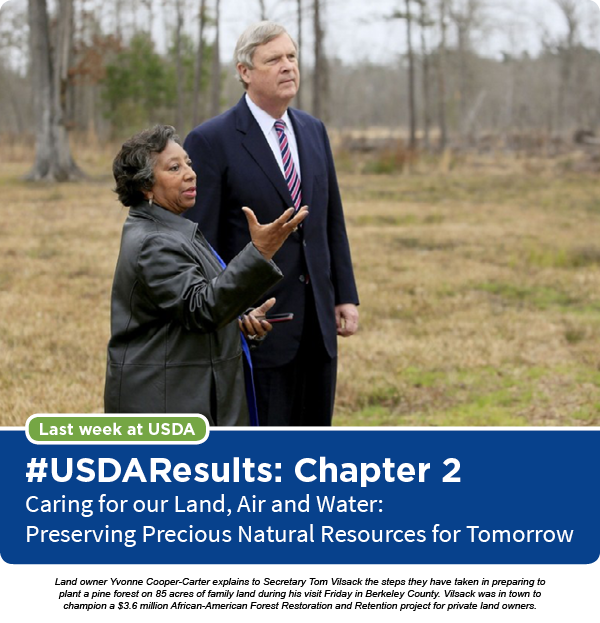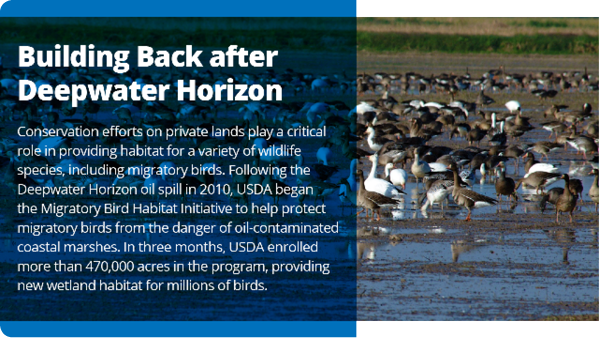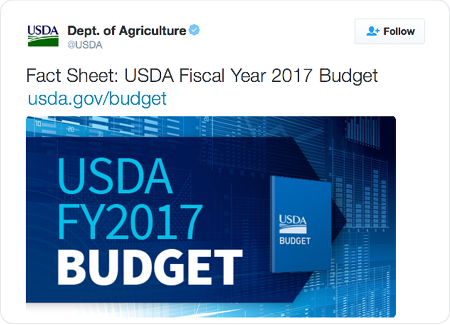Having trouble viewing this email? View it as a Web page.

In a country as geographically diverse as the United States, there can be no one-size fits all approach to conservation. USDA’s Regional Conservation Partnership Program (RCPP), launched in 2015, brings a new approach to investing in natural resource conservation by empowering local communities to work with partners to design and invest in regional solutions that work best for them.
Be sure to take a look at how historic investments from USDA over seven years have supported our farmers, ranchers, and growers, yielding positive results for American agriculture and for the American people: https://medium.com/usda-results.
Reducing Energy Use and Costs & Getting #USDAResults for Virginia Businesses and Farmers This week in Virginia, USDA Rural Development announced eight Rural Energy for America (REAP) grants totaling $107,500. It’s always an honor to award REAP grants because they help Virginia’s rural businesses by rewarding innovation. The REAP program helps rural businesses and agricultural producers save money, make their operations more energy efficient, and protect the environment.
In 2012, USDA designated 2,245 counties in 39 states as disaster areas due to drought, or 71 percent of the United States. Many of the country’s livestock producers faced the ultimate decision – liquidate or figure out a way to survive. Ranchers across the state had planned to graze their livestock through the spring and summer, but found their pastures scorched by the hot sun, and their ponds dry. Helping Small Farmers in the South Go Organic Rock Woods, Gulf States Regional Director for the National Center for Appropriate Technology (NCAT), knows the importance of persistence. Rock wanted to help more farmers in the southeast learn about organic certification, but he also knew that farmers are busy. That’s why Rock and NCAT launched a sustained engagement and outreach effort to reach potential organic farmers, and his persistence paid off! From Devastation to Restoration Wildfires in sagebrush and other range ecosystems are increasing in frequency and severity, often in relation to drought conditions and intrusive species like cheatgrass, a non-native, highly flammable invasive species that establishes itself as a monoculture and crowds out native grasses and forbs. 2016 Agricultural Outlook Forum: How Land Tenure & Transition Can Transform the Rural Economy Focus on land tenure and transition issues has grown considerably in recent years, especially its impact on new and beginning farmers. “New and beginning farmers are the future of American agriculture,” said Deputy Secretary Harden. “The average age of an American farmer is 58 and increasing, so we must help new farmers get started if America is going to continue feeding the world and maintain a strong agriculture economy.” As the age of the principal farm operator continues to increase, the focus on this issue intensifies. A Walk in the Woods and Never be “The Marching Man” On a sunny January morning in 2010, Tony Tolsdorf had no idea that a walk in the woods would become the longest night of his life. “It was really warm that morning, probably 55 or 60 degrees,” he recalls. “It was one of those days where you just have to get outside and do something, so I went for a hike in the Columbia River Gorge.” Hundreds of Free Webinar Series Offer On-Demand Conservation Training Conservation science is a broad, deep field that’s growing all the time. To help people brush up on conservation practices and learn about new technologies, USDA’s Natural Resources Conservation Service offers hundreds of free conservation webinars from its online Science and Technology Training Library. USDA Scientists Take an Organic Approach to Improving Carrots Organic carrots are coming into their own. About 14 percent of U.S.-produced carrots are now classified as organic, making carrots one of the highest ranked crops in terms of the total percentage produced organically. With production and demand increasing in recent years, organic-carrot growers need help deciding which varieties to grow. Western Water Threatened by Wildfire As we get ready for the 2016 wildfire season, a recent report from the American Forest Foundation (AFF) looks at one of the most important, but often overlooked, issues related to forest health: the relationship between water supply and the risk of fire to our forests.
Fight looms over federal wildfire funding after devastating year (San Francisco Chronicle) After the costliest of wildfire seasons ravaged the West last year, with three catastrophic blazes ripping through Lake County, the U.S. Forest Service may be headed for a showdown with Congress over how to cover the surging bill. U.S. Agriculture chief launches support program for wary black forestland owners (The Post and Courier) When Yvonne Cooper-Carter heard about a federal program offering help for forest owners who are black, she was wary. When U.S. Agriculture Secretary Tom Vilsack showed up in her community Friday, he faced some pointed questions. Members of the Cooper family own a total of more than 300 acres in the Cherry Hill community outside Moncks Corner. The land goes back more than 100 years in the family name, rife with stories of Farm Bureau discrimination.
Military bases in three U.S. states will share $17.5 million in conservation funding to protect longleaf pine forests used for training troops while assisting the recovery of threatened species, Agriculture Secretary Tom Vilsack announced Friday. Fort Stewart shares in conservation grant (Savannah Morning News) Military bases in three U.S. states will share $17.5 million in conservation funding to protect longleaf pine forests used for training troops while assisting the recovery of threatened species, Agriculture Secretary Tom Vilsack announced Friday. Partnership to improve environment, farmland receives $16M boost (Traverse City Record Eagle 2/12) Northwest Michigan farming and conservation groups will receive nearly $16 million in public and private investment. The Tribal Stream and Michigan Fruitbelt Collaborative was created by the Farm Bill's Regional Conservation Partnership Program. The collaborative includes the Grand Traverse Band of Ottawa and Chippewa Indians, the Grand Traverse Regional Land Conservancy, the Leelanau Conservancy and the Conservation Resource Alliance. U.S. Sen. Debbie Stabenow announced the news in a Friday morning press release.
Agriculture Secretary Tom Vilsack expects softening commodity prices and land values to create stiff competition among the nation’s farmers to enroll their marginal cropland into a popular conservation program this year. California secures more than $12 million in USDA invasive species funding (Imperial Valley News) Sacramento, California - The USDA’s Animal and Plant Health Inspection Service (APHIS) has allocated $58.25 million from Section 10007 of the 2014 Farm Bill. This money will support 434 projects that prevent the introduction or spread of plant pests and diseases that threaten U.S. agriculture and the environment and ensure the availability of a healthy supply of clean plant stock in the United States.
USDA 2017 Budget Request Asks for New Way To Pay for Fighting Wildfires Fewer CRP Acres May Not Mean Less Conservation Results Public Service Announcement - Fighting Drug Abuse in Rural Communities
|
















